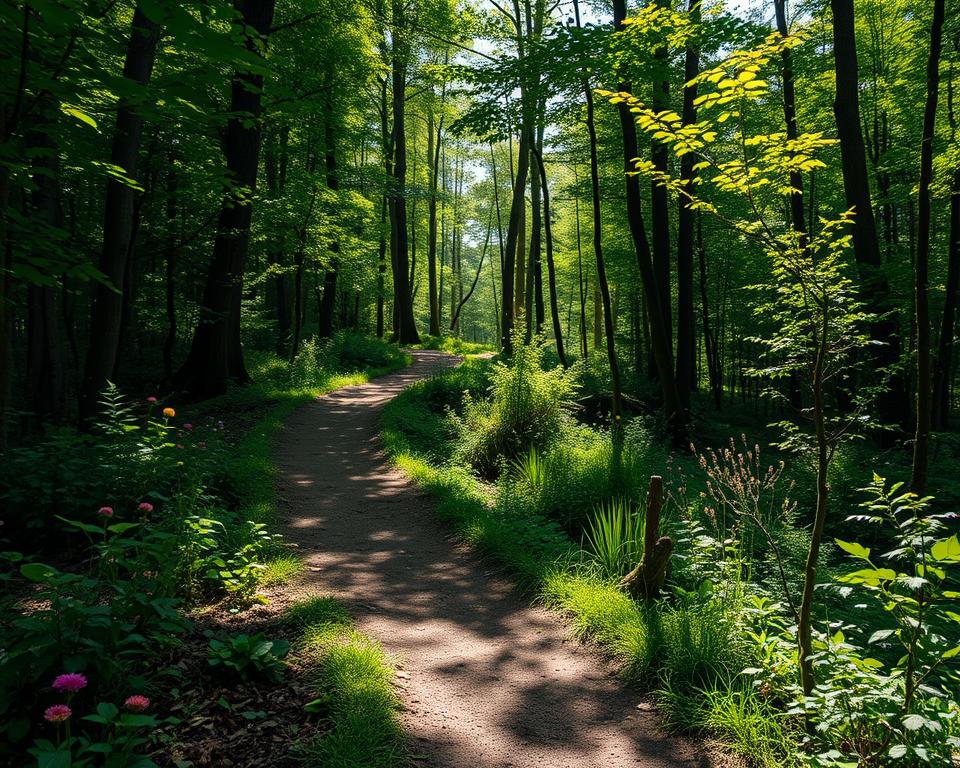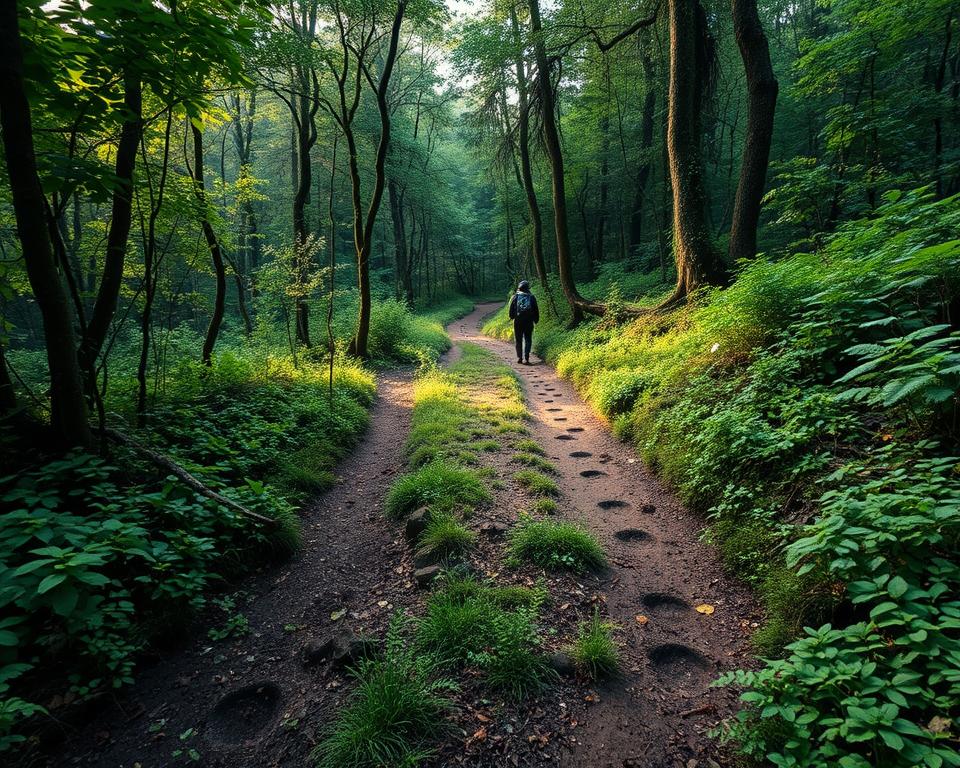Hiking lets us connect with nature, especially during spring. But, we must think about our ecological footprint outdoors. The need for sustainable hiking is clear, with carbon emissions dropping by 5.8% in 2020. Still, our activities threaten our trails and natural areas.
To hike eco-consciously is to save trails and lessen environmental harm. Although humans cause up to 90% of U.S. wildfires, mindful hiking can save nature. Following simple green tips helps keep our favorite spots clean and inviting.
Regardless of if you’re experienced or new, using eco-friendly hiking methods protects our trails and ecosystems. This way, future generations can enjoy nature’s beauty and peace, without environmental damage.
Introduction to Eco-Friendly Hiking
Eco-hiking is more than just walking on scenic trails. It means caring for the environment while hiking. By choosing the right gear and handling waste properly, we protect nature. Our choices on the trail are crucial for both our experience and the future of these places.
Imagine if each hiker picked up one piece of trash each day. This would add up to 365 pieces of trash a year. Now, if everyone picked up two pieces, we’d have 730 pieces a year. Small actions like this keep our trails clean and beautiful.
Choosing the right gear is key to sustainable hiking. Many backpacks are made from polluting materials like nylon and polyester. Selecting gear from recycled materials can reduce pollution. Clothes made from organic cotton or bamboo are also good choices. Bamboo fabric is anti-bacterial, adding comfort and hygiene to hikes.
Using reusable items is another step towards eco-hiking. Swapping single-use plastics for reusable bags and bottles helps the planet. Reusable water bottles, especially those made from safer materials, cut down on pollution.
Keeping our food away from wildlife is important. It helps them stay wild and keeps nature balanced. Following the 7 Leave No Trace principles is also key to minimal impact hiking. These steps ensure we leave nature as we found it.
Being responsible outdoors means more than just taking our trash home. We must also bury human waste properly, away from water, trails, and camps. Eco-hiking embodies respect for nature in every step. It’s about ensuring the trails are there for future generations.
Shopping for Sustainable Hiking Gear
As I prepare for my next hiking trip, finding the right sustainable gear is key. Looking for eco-friendly hiking apparel helps protect our trails. It also supports brands that positively impact the planet.
Choosing Recycled Materials
It’s important to choose hiking items made from recycled materials. Many green brands use recycled plastic, organic cotton, merino wool, and bamboo. These materials cut down on waste, make gear last longer, and support smart shopping.
- Recycled Polyester: Often used in jackets and backpacks, recycled polyester saves energy and reduces greenhouse gas emissions compared to virgin polyester.
- Organic Cotton: Grown without harmful pesticides, organic cotton is softer and better for the environment. It’s commonly used in t-shirts and pants.
- Merino Wool: Known for its antimicrobial, moisture-wicking, and breathable properties, merino wool is perfect for socks and base layers.
- Bamboo: Bamboo’s rapid growth and minimal water use make it a sustainable choice for items like t-shirts and leggings.
Eco-friendly materials often make gear more durable. This saves you money over time.
Brands That Give Back
It’s vital to support brands that care for the environment. I look for markers like Bluesign, Fair Trade Certified, and GOTS when shopping. These show that the products meet strict environment and ethical rules.
- Patagonia: Known for its commitment to environmental activism, Patagonia uses a high percentage of recycled materials and offers repair services to extend the lifespan of products.
- TenTree: For every item sold, TenTree plants ten trees, aiming to reduce carbon footprint and restore ecosystems.
- United by Blue: This brand removes one pound of trash from oceans and waterways for every product sold, making a substantial impact on our planet’s health.
- Prana: With a focus on fair labor practices and sustainable materials, Prana offers a range of durable and stylish hiking apparel.
These eco-friendly brands not only offer top-notch, environmentally responsible hiking apparel. They also reflect the values important to hikers. By choosing their products, we support eco-friendly and ethical practices. Thus, our hiking trips help the planet.
Adhering to Leave No Trace Principles
The Leave No Trace ethics help us hike without harming nature. By following these rules, we keep our natural places beautiful and sustainable. It’s up to us hikers to enjoy nature without ruining it.
Dispose of Waste Properly
Getting rid of waste the right way is key to stop pollution and protect animals. Always carry out all trash, including leftovers. Use a cathole for human waste. Make it 6 to 8 inches deep and away from water and trails, about 200 feet.
The Leave No Trace Center teaches us this to lessen our mark on nature.
Respect Wildlife and Plant Life
Respecting wildlife means keeping your distance and not feeding them. Don’t take plants or rocks either. Feeding animals can make them sick and dangerous.
Following Leave No Trace helps save wildlife. We ensure nature stays safe for everyone in the future.
Best Eco-Friendly Hiking Practices
Eco-friendly hiking is more than just loving nature. It’s about keeping it alive for those coming after us. A key part of this mission is sticking to marked trails. This helps limit our impact on fragile ecosystems.
Sticking to Established Trails
When we emphasize established trail use, we mean sticking to specific paths. This approach helps avoid harm to the environment. These trails are made to protect plants and wildlife homes alongside them.
By keeping to the trails, we fight minimizing soil erosion and support backcountry preservation. These paths ensure our hiking is safe while protecting wildlife and plants. For instance, some plants might take years to grow back if we step on them. This shows how important our steps are.

Going off-trail can also spread harmful, non-native species. This harms the natural growth of local plants. Staying on the paths helps save the plants. It also aids in making the scenery sustainable for future enjoyment.
- Promote backcountry preservation by using marked trails.
- Help keep trails in good shape by joining maintenance programs.
- Don’t take shortcuts. Always stick to the trail to help in minimizing soil erosion.
Whether it’s the Appalachian Trail or a simple park walk, using marked paths is vital. It helps the environment in the long run. Our careful choices during hikes can protect nature. Let’s make our hikes help the planet.
Reducing Single-Use Plastics and Wastes
Keeping nature safe while hiking is essential. We can do this by using less single-use plastics. By choosing reusable options for water, food storage, and trash, we make a big difference.
Using Reusable Water Bottles
Using reusable water bottles is a key move against single-use plastics. Bottles made of stainless steel, like Hydro Flask, can be recycled many times. This makes them a better pick than plastic ones. Even though Smart Water bottles are for one-time use, hikers often reuse them because they’re light. Still, getting something sturdy like CamelBak or Platypus Bladders is better for the environment and lasts longer.
When thinking about clean drinking water, options like the LifeStraw or Steri-Pen Recharable USB are good. They help cut down on plastic waste and ensure the water is safe.
Secure Food and Minimize Packaging
Smart food storage is crucial for eco-friendly hiking. Using items like ReZip and Lunchskins instead of single-use bags is a step forward. Even though Stasher Silicone bags might be heavier, they’re great for heating food outdoors.
Beeswax wraps are good for wrapping food, and Eagle Creek Dropper bottles are great for liquids. Places like national parks often need hikers to use bear canisters. This keeps food safe and protects wildlife.
Always bring a trash bag to keep the trail clean. Choosing menstrual cups over disposables also helps minimize waste. With these actions, we support the health of our trails and nature.
How Can Eco-Friendly Hiking Practices Help Protect Wildlife on the Trail?
Embracing eco-friendly hiking practices is essential for protecting wildlife on the trail. By following specific tips for preserving wildlife on trails, hikers can minimize their impact, ensuring habitats remain intact. Simple actions like staying on designated paths and carrying out litter contribute to a healthier ecosystem for all creatures.
Conclusion
Eco-friendly hiking is more than just enjoying nature. It’s a promise to protect our trails and be outdoors sustainably. Over 9 million Americans love hiking, and together, we make a big difference. Choosing gear made of bamboo or recycled stuff helps the planet and cuts down on trash.
We can do a lot by following the seven Leave No Trace rules. Throwing away trash properly, being kind to wildlife, and staying on paths are key. If we use bottles we can refill and cut down on wrappers, our trails stay clean and beautiful for everyone.
It’s great to support local shops that sell outdoor things and help plant trees near trails. Every little action matters. From watching animals safely, keeping pets on leashes, to eating plant-based foods on hikes, it all shows our love for green hiking. By doing this, I make my outdoor adventures mean more. They’re not just fun for me, but good for the planet too. This way, nature will be here for others to enjoy long after us.

